skip to main |
skip to sidebar
My first trip on the Circle Line in Yangon, back in 2008 (described in the post The Circle Line, Yangon) allowed me to identify the main locomotive works of Myanma Railways at Insein, a few miles north of downtown Yangon.
It was not until 20th September 2012 that I discovered that there was a second locomotive works at Ywa Taung (not too far from Mandalay). I'd been with the Doctor to make donations to the Monastic School at Taung Be Lar (described in the post Mandalay) and we took a different route returning which took us past Ywa Taung Station. We stopped and I took a number of pictures which are in the album here (together with additions from later visits).
The Rangoon Guide Map of 1930 (published under the direction of Brigadier R. H. Thomas D.S.O., Surveyor General of India) shows the Works, to the west of Insein railway station.
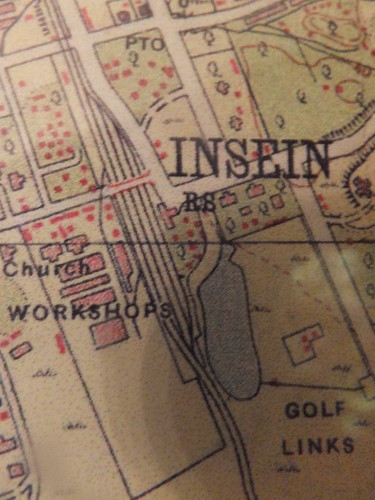
1930 Map of Insein area (more pictures of the 1930 map are here).
On subsequent Circle Line Trips I'd looked 'over the wall' at Insein Works but it was not until my friend, the Doctor, obtained permission for a visit on the 6th May 2015 that I was able to gather more information.
Visit to Insein Locomotive Works
We reported to the Time Office at the Main Gate and were welcomed by the Works Manager before one of his staff took us on a tour of the Works. Despite the urban environment, we first passed through a pleasant landscaped area with a concrete sports ground on our left.
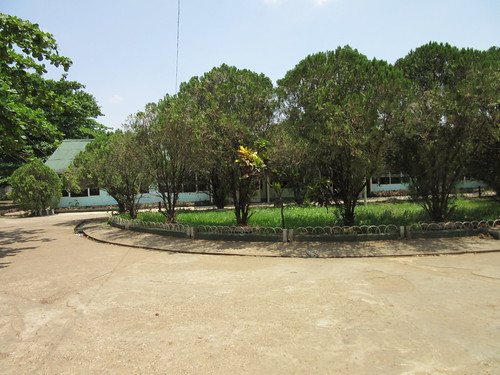 The landscaped area near the main gate.
The landscaped area near the main gate.
However, we quickly passed into a more unkempt but attractive wooded area with a number of diesel locomotives either awaiting 'shopping' or cannibalisation for spare parts.
 DF.1318 (and others) slumber beneath the trees in Insein Works Yard.
DF.1318 (and others) slumber beneath the trees in Insein Works Yard.
Nearby, I found the remains of a number of cut-up steam locomotives. As a dyed-in-the-wool steam enthusiast, I regret the loss of any steam locomotive but it has to be said that there is great educational value in being able to see the internal construction of these machines.
 Insein Works: Cut-up steam locomotives.
Insein Works: Cut-up steam locomotives.
Overlooking this scene of destruction was a plinthed outside-cylinder 0-6-0 oil-burning saddle tank, running number SL3 and gaily-painted.
 Plinthed SL3 at Insein Works.
Plinthed SL3 at Insein Works.
The principal business of Insein Works is carrying out heavy repairs on the fleet of diesel electric and diesel hydraulic locomotives. This task is shared with Ywa Taung Locomotive Works. Insein also carries out re-engining and rebuilding as necessary. The main works at Insein comprises two large, parallel, interconnected bays: the Machine Shop and the Erecting Shop.
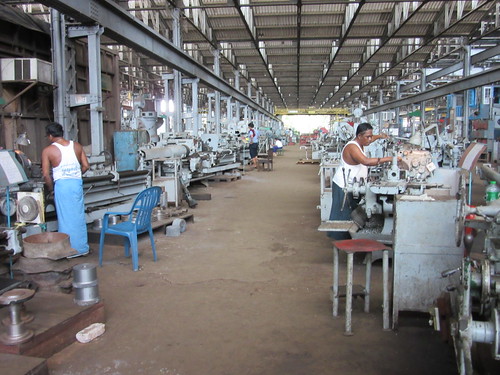 The Machine Shop.
The Machine Shop.
Most of the machines are British and date from the immediate post-World War II period. Burma Railways emerged from the war in a particularly weakened condition and, although Britain initially provided assistance, the coup which led to military rule had the effect of largely isolating Burma from foreign aid until recently.
 Part of the Erecting Shop, looking north.
Part of the Erecting Shop, looking north.
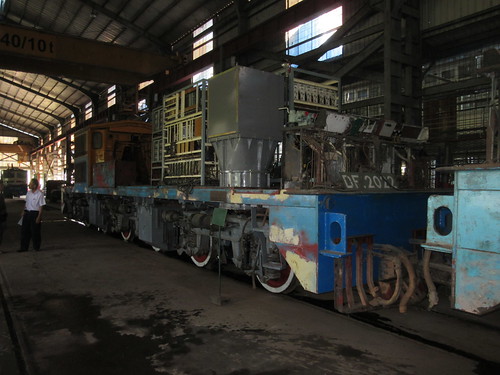 DF.2022, showing racks of electronics.
DF.2022, showing racks of electronics.
A number of the locomotive classes I'm familiar with were visible, in various states of 'undress', but my attention was drawn to a locomotive with a very large cab. This was a rebuild by Insein of a Japanese class DD-51.
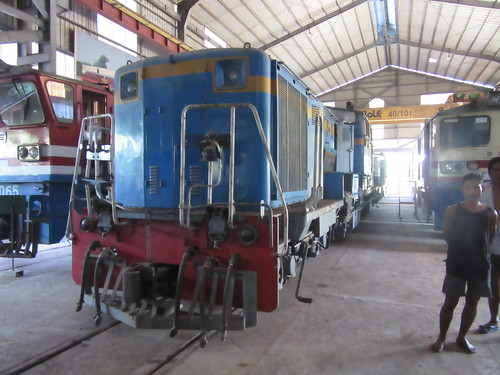 Part of the Erecting Shop, looking south, showing rebuilt Japanese DD-51 locomotive.
Part of the Erecting Shop, looking south, showing rebuilt Japanese DD-51 locomotive.
In its original form, this diesel hydraulic locomotive class had two 1100 h.p. engines and was carried on six axles with the two axles under the cab unpowered (B-2-B), giving an overall length of 18 metres! Designed for freight and passenger use, I believe the large cab originally accommodated a steam boiler for train heating. There's a Wikipedia article here.

DD-51 as originally built (By ja:User:出々 吾壱, via Wikimedia Commons).
I wasn't able to make a detailed study, but Insein appear to have removed one engine and power bogie, producing an 1100 h.p. variant.
I was delighted to find one steam locomotive under active restoration with, apparently, another to follow. I was told that they had already 'outshopped' one restored steam locomotive which is now available for tourist trains in the Bagan area.
 The frames of a 2-8-2 being aligned, using traditional methods.
The frames of a 2-8-2 being aligned, using traditional methods.
I made a rapid tour of the Scrap Line outside, recording what I could.
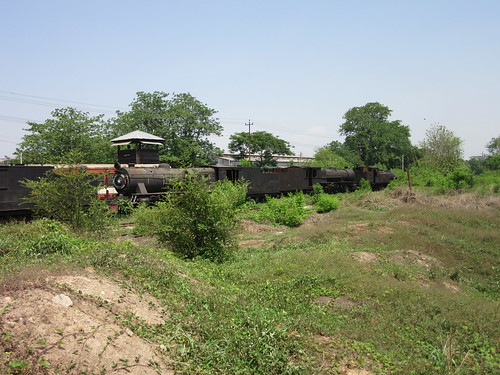 Part of the Scrap Line at Insein.
Part of the Scrap Line at Insein.
I reluctantly concluded my tour, impressed by the ingenuity, professionalism and friendliness of the staff. Before I left, the Works Manager gave me a copy of a booklet 'Brief Information of Insein Locomotive Workshop', updated to April 2015.
My pictures
Insein Locomotive Works, Yangon.
Insein Locomotive Works: Machine Shop.
Insein Works: Cut-up steam locomotives.
Insein Works Scrap Line.
Restoring steam locomotives at Insein.
Plinthed SL3 at Insein Works.
[Text, pictures and 1930 map added 25-May-2015]
My first trip on the Circle Line in Yangon, back in 2008 (described in the post The Circle Line, Yangon) gave me a tantalising glimpse of the extensive sidings in the Mahlwagon Area (just north of downtown Yangon).
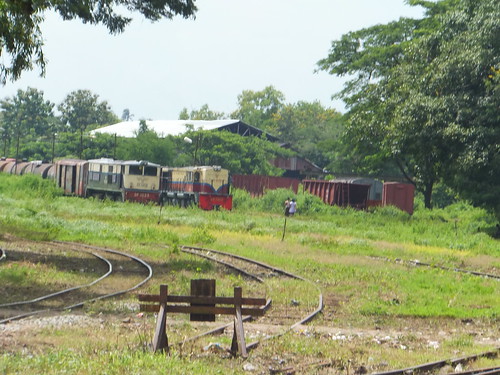 The northern end of Mahlwagon Marshalling Yard, viewed from a Circle Line Train in 2012.
The northern end of Mahlwagon Marshalling Yard, viewed from a Circle Line Train in 2012.
Studying the satellite photographs on Google confirmed the complexity of the infrastructure and revealed a large roundhouse. Later, I found the Rangoon Guide Map of 1930 (published under the direction of Brigadier R. H. Thomas D.S.O., Surveyor General of India) which gave more detail of the facilities and suggested that the yard was probably once far busier serving the extensive docks than at present.
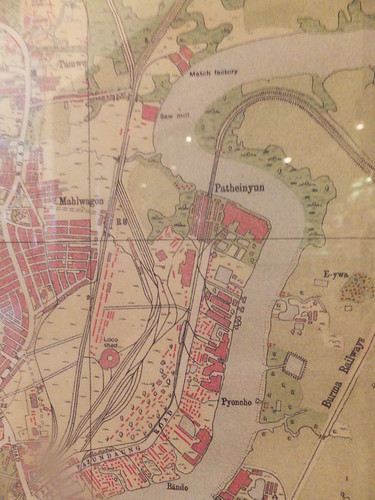
1930 Map of Mahlwagon area (more pictures of the 1930 map are here).
Road access to the area appeared limited and my various explorations of Yangon on foot failed to reach as far as this interesting district. But my friend, the Doctor, obtained permission for us to visit what is still a Restricted Area on the 6th May 2015.
Visit to Mahlwagon Marshalling Yard
We reported to the Yardmaster's Office, where we were made welcome by the Yardmaster and his staff.
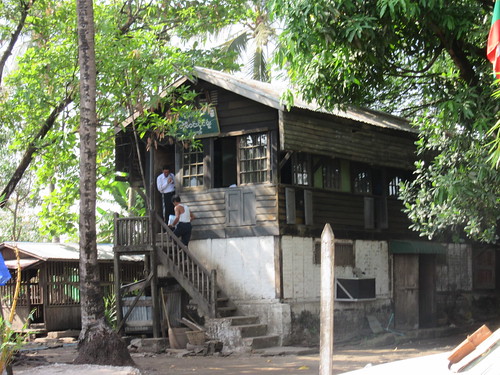 The Yardmasters Office.
The Yardmasters Office.

The Yardmaster.
My attention was immediately drawn to a large, painted diagram of the yard.
 Down Yard with main lines (top) and Locomotive Shed (top middle).
Down Yard with main lines (top) and Locomotive Shed (top middle).
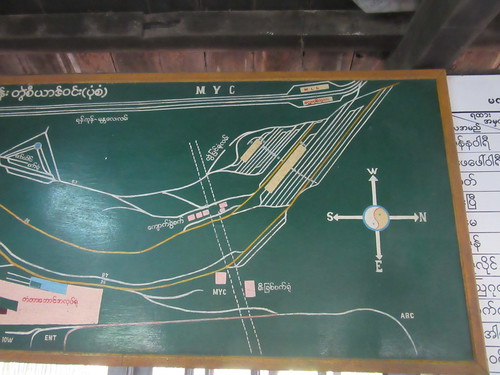 Up Yard with main lines (top) and Mahlwagon Station (top right).
Up Yard with main lines (top) and Mahlwagon Station (top right).
The access road crossed a number of lines in between the Down and Up Yards on the level and DD.521 was shunting at the south end of the Up Yard so, every time the locomotive drew out a raft of wagons, the access road was blocked.
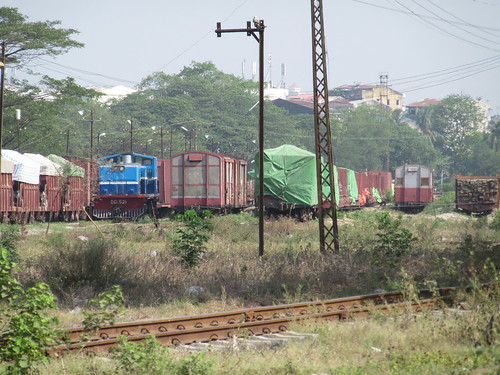 View from the access road looking north, with DD.521 shunting the Up Yard.
View from the access road looking north, with DD.521 shunting the Up Yard.
Once over the lines, there was a large pool on the left, then a housing colony of what I presumed were railway workers. In addition to the houses, we passed a railway medical clinic before we arrived at the gate of the diesel shed.
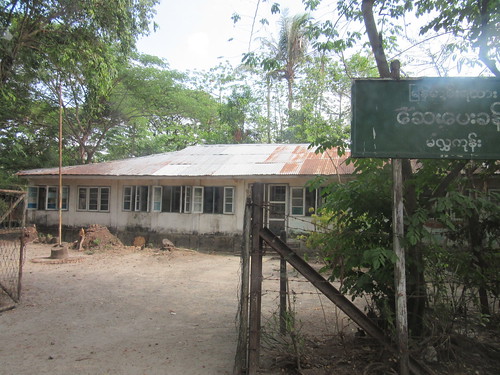 Mahlwagon Marshalling Yard: The Railway Clinic.
Mahlwagon Marshalling Yard: The Railway Clinic.
Visit to Mahlwagon Diesel Locomotive Shed
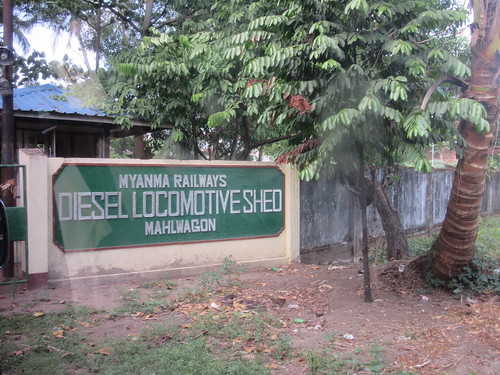 The entrance to the Diesel Locomotive Shed.
The entrance to the Diesel Locomotive Shed.
We entered the yard and followed the road through the trees. On the right, I spotted the plinthed saddle tank steam locomotive I'd seen on my first ride on the Circle Line, on 7th March 2008. On our left, we passed a number of the 1100 h.p. Chinese locomotives in green livery, looking as if they'd been laid aside. DD.1112 and DD.1128 were amongst them. We parked near railcar RBE.30.01 which I'd seen around Yangon. The man from the Yardmaster's office who'd accompanied us made introductions to the Shed Foreman who took us into the shed and immediately started a tour. We were in a 2-track extension to the roundhouse which appeared to serve as the arrival and departure area. Outside, the two tracks gave access to the goods lines at Pazundaung and Yangon Central station. A structure between the two tracks supported a header tank with flexible discharge hoses. On one side, there was a large silver-painted tank farm, presumably for fuel, behind a wall or bund. Two portable compressors could be seen.
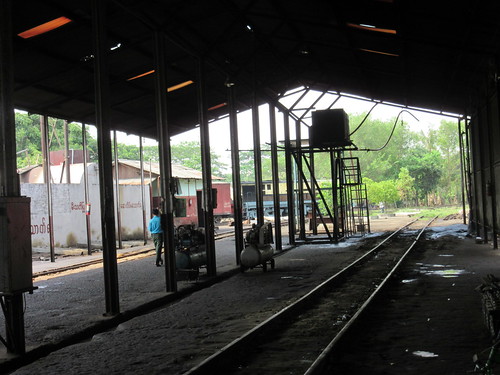 The 2-track extension.
The 2-track extension.
A large sign in Burmese and English read "I WILL BE ALWAYS SURE". We entered the roundhouse itself, a large structure with the roof supported by elaborate steel trusses and a single, curved wall on the outside with regular large, glazed windows. The roof was split into two pitched sections joined by a vertical, glazed section. In a roundhouse, of course, the individual roads radiate from a turntable which was visible outside. Within the roundhouse, each road was provided with an inspection pit. In most cases, the pit was wider than the track gauge and the rails were supported on a series of steel and concrete pillars giving good access for maintenance but, on some roads, the pit was of the traditional pattern, with the width limited by the track gauge. Some roads were provided with a permanent access platform with steps, allowing staff to work at running plate level. Each road terminated in a rail-built stop.
 Mahlwagon Roundhouse, looking anti-clockwise from the arrival/departure roads.
Mahlwagon Roundhouse, looking anti-clockwise from the arrival/departure roads.
 Mahlwagon Roundhouse, looking clockwise from the arrival/departure roads.
Mahlwagon Roundhouse, looking clockwise from the arrival/departure roads.
We walked anti-clockwise from the arrival/departure roads and I made a note of the roads and the stabled locomotives:-
DF.2058, DF.1348, DF.1637, DF.1358, DF.1339, DF.1347, (empty), DF.2017, DF.1239, DF.2066, DF.1200.02, DF.1317, DF.2061, (empty), DF.1349, (empty), DF.1201, (empty), DD.517.
We then moved outside the shed, where the attraction was two steam locomotives laid aside - a coal-burning 'Pacific' (pictures here) and ST772, a 2-6-4 tank engine arranged for oil burning (pictures here). I'll describe these locomotive classes later.
We walked back through the shed to reach the turntable, a 120-ton 'Mundt' type supplied in 1946 by Ransomes and Rapier Limited, Ipswich. It appears to be 65 feet diameter. Although the turntable is electric, various problems mean that it presently has to be hand-operated. In a roundhouse, every locomotive arriving or departing has to be turned on the turntable to access the required road so the lack of electric operation is very inconvenient.
We watched DF.1637 on and off the turntable. This locomotive was uprated to 2000 h.p. when an MOI 16V170 engine was fitted by Insein in 2013. Wärtsilä and Cummins had a short-lived joint venture which I believe originally produced the 16V170.
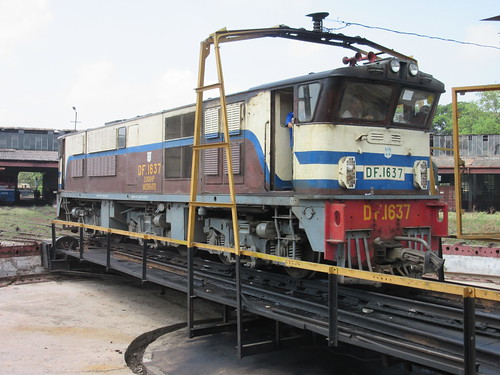 DF.1637 on the turntable at Mahlwagon.
DF.1637 on the turntable at Mahlwagon.
We briefly looked at a building under construction with a high roof served by a single siding not radiating from the turntable. The structure was fitted with overhead travelling crane rails so I presumed that this was intended to give the shed improved lifting facilities in the future.
 New building awaiting fitting-out.
New building awaiting fitting-out.
Our attention then turned to the 'clockwise' part of the shed which appeared to be involved in more major repairs. Outside the shed we found an Engineer's Rail Gang Car numbered ED/RGC.100, DF.1345 (an Alco-designed locomotive purchased second-hand from India fully refurbished), DD.1114 and DD.1119, both in Green livery, allocated to Mandalay and looking rather sorry for themselves.
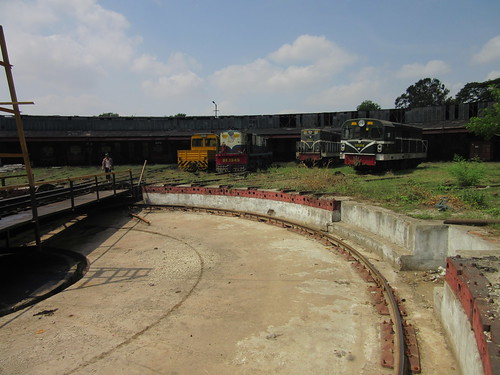 Mahlwagon Shed viewed from the turntable.
Mahlwagon Shed viewed from the turntable.
Another 1100 h.p. locomotive was half inside the shed. On the adjacent road, DF.2026 was positioned on four 'GEDI' lifting jacks, presumably for exchanging bogies. GEDI (Gebr. Dickertmann) was founded in Bielefeld, Germany, in 1843 and was acquired by NEUERO Technology GmbH in 1990 forming a world-wide supplier of equipment for the maintenance of railway vehicles. Nearby, DF.1322 was parked. There was a modern Test Bench for JZ6 and JZ7 air brake parts (Chinese designs).
 Test Bench for air brake parts.
Test Bench for air brake parts.
Outside the shed, we found an Orton McCulloch Diesel Crane, running number 45.T.DC.9892. The crane was carried on two six-wheel bogies with the jib supported on a bogie flat wagon. 'ABC' couplers were provided.
We then made our way back through the shed towards the Arrival Roads, where DF.1330 had just come 'On Shed'. As we watched, a second light engine, DF.1351, was just arriving behind DF.1330. Nearby, the Shed Foreman was anxious to show us one of the Japanese one-car railcars, RBE.30.01, externally looking very smart in a mainly-red with cream livery.
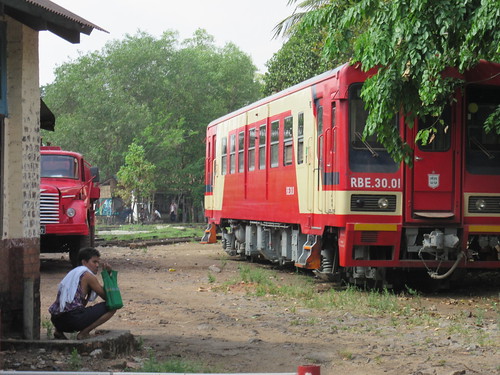 Railcar RBE.30.01 outside the shed at Mahlwagon.
Railcar RBE.30.01 outside the shed at Mahlwagon.
The Shedmaster had offered to meet us after our tour, so we were taken to his office and chatted for a while. One of the topics which was raised was their turntable, and the problems associated with currently having to operate it manually. I was invited to express an opinion and, despite making it plain that I had only limited knowledge of turntables, I found myself being led back to the turntable in order to clamber down into the pit and have a closer look at the mechanism. I'll put the details of my rather informal survey in a separate report.
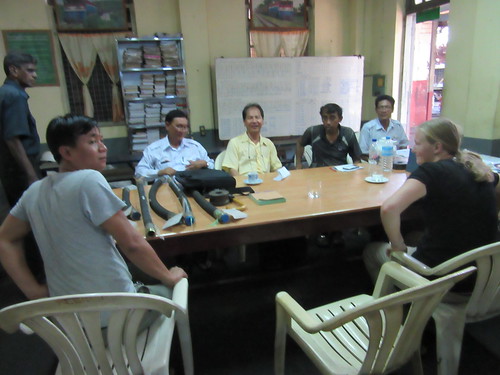 The meeting in the Shedmaster's Office.
The meeting in the Shedmaster's Office.
We then expressed our thanks for a fascinating visit and said our 'goodbyes'. I had just one more task before we drove away - to photograph the diminuitive saddle tank plinthed just inside the shed boundary wall which I'd first spotted on 7-Mar-2008 (that picture is here). Fortunately, the locomotive still carried its Kerr-Stuart worksplate (No. 1284 of 1914) so, on my return to England, I was able to find a little more.
To find out what happened next on this trip, go to the post Yangon (Part 4).
All my posts describing Myanma Railways can be found here.
My pictures
The following albums (on Flickr) contain pictures relevant to this post:-
Mahlwagon Marshalling Yard, Yangon.
Mahlwagon Diesel Locomotive Shed.
Mahlwagon Diesel Shed Turntable.
'Pacific' at Mahlwagon.
Tank Engine at Mahlwagon.
Plinthed Kerr-Stuart at Mahlwagon.
All my pictures showing Myanma Railways can be found here.
[Text and pictures added 1-Jun-2015, 6-Jul-2015]

 The landscaped area near the main gate.
The landscaped area near the main gate.
 DF.1318 (and others) slumber beneath the trees in Insein Works Yard.
DF.1318 (and others) slumber beneath the trees in Insein Works Yard.
 Insein Works: Cut-up steam locomotives.
Insein Works: Cut-up steam locomotives.
 Plinthed SL3 at Insein Works.
Plinthed SL3 at Insein Works.
 The Machine Shop.
The Machine Shop.
 Part of the Erecting Shop, looking north.
Part of the Erecting Shop, looking north.
 DF.2022, showing racks of electronics.
DF.2022, showing racks of electronics.
 Part of the Erecting Shop, looking south, showing rebuilt Japanese DD-51 locomotive.
Part of the Erecting Shop, looking south, showing rebuilt Japanese DD-51 locomotive.

 The frames of a 2-8-2 being aligned, using traditional methods.
The frames of a 2-8-2 being aligned, using traditional methods.
 Part of the Scrap Line at Insein.
Part of the Scrap Line at Insein.


















